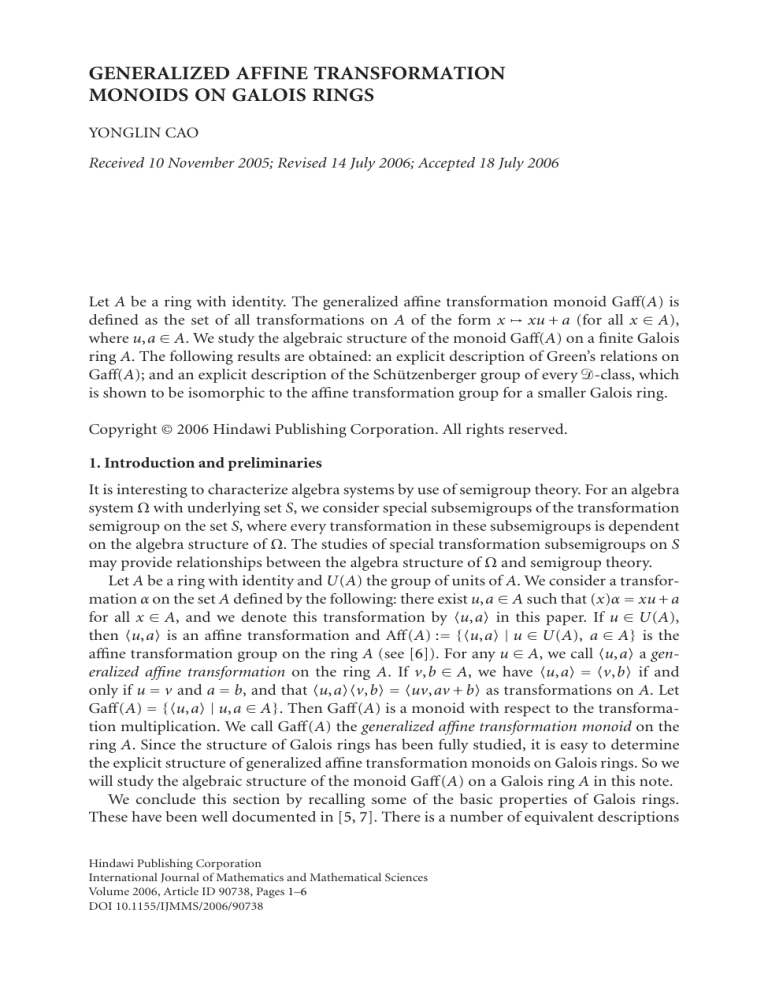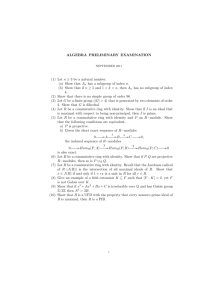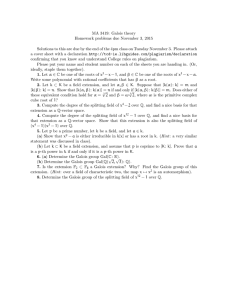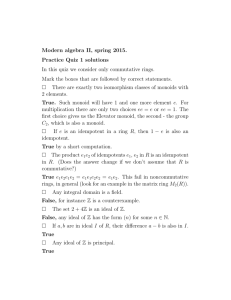
GENERALIZED AFFINE TRANSFORMATION
MONOIDS ON GALOIS RINGS
YONGLIN CAO
Received 10 November 2005; Revised 14 July 2006; Accepted 18 July 2006
Let A be a ring with identity. The generalized affine transformation monoid Gaff(A) is
defined as the set of all transformations on A of the form x → xu + a (for all x ∈ A),
where u,a ∈ A. We study the algebraic structure of the monoid Gaff(A) on a finite Galois
ring A. The following results are obtained: an explicit description of Green’s relations on
Gaff(A); and an explicit description of the Schützenberger group of every Ᏸ-class, which
is shown to be isomorphic to the affine transformation group for a smaller Galois ring.
Copyright © 2006 Hindawi Publishing Corporation. All rights reserved.
1. Introduction and preliminaries
It is interesting to characterize algebra systems by use of semigroup theory. For an algebra
system Ω with underlying set S, we consider special subsemigroups of the transformation
semigroup on the set S, where every transformation in these subsemigroups is dependent
on the algebra structure of Ω. The studies of special transformation subsemigroups on S
may provide relationships between the algebra structure of Ω and semigroup theory.
Let A be a ring with identity and U(A) the group of units of A. We consider a transformation α on the set A defined by the following: there exist u,a ∈ A such that (x)α = xu + a
for all x ∈ A, and we denote this transformation by u,a in this paper. If u ∈ U(A),
then u,a is an affine transformation and Aff(A) := {u,a | u ∈ U(A), a ∈ A} is the
affine transformation group on the ring A (see [6]). For any u ∈ A, we call u,a a generalized affine transformation on the ring A. If v,b ∈ A, we have u,a = v,b if and
only if u = v and a = b, and that u,av,b = uv,av + b as transformations on A. Let
Gaff(A) = {u,a | u,a ∈ A}. Then Gaff(A) is a monoid with respect to the transformation multiplication. We call Gaff(A) the generalized affine transformation monoid on the
ring A. Since the structure of Galois rings has been fully studied, it is easy to determine
the explicit structure of generalized affine transformation monoids on Galois rings. So we
will study the algebraic structure of the monoid Gaff(A) on a Galois ring A in this note.
We conclude this section by recalling some of the basic properties of Galois rings.
These have been well documented in [5, 7]. There is a number of equivalent descriptions
Hindawi Publishing Corporation
International Journal of Mathematics and Mathematical Sciences
Volume 2006, Article ID 90738, Pages 1–6
DOI 10.1155/IJMMS/2006/90738
2
Generalized affine transformation monoids on Galois rings
of Galois rings: they are the separable extensions of finite, unital, local, commutative rings
and the unramified extensions of such rings. Let T be a finite, local, commutative ring
with unity and has a maximal ideal (p) for some prime p. A polynomial h(x) ∈ T[x]
is called basic irreducible if it is irreducible modulo p. We construct the Galois ring as a
quotient ring of Z pn [x] as follows. Let n and m be positive integers and let h(x) ∈ Z pn [x]
be a monic basic irreducible polynomial of degree m. The quotient ring Z pn [x]/(h(x)),
denoted GR(pn , pnm ), is called the Galois ring of order pnm and characteristic pn . Moreover, the integers p, n, and m chosen as above determined uniquely (up to isomorphism)
the Galois ring GR(pn , pnm ) [7, page 207]. For the remainder of the text the symbol A
will denote the Galois ring GR(pn , pnm ). It is known that all ideals of A are given by
(0) = (pn ) ⊂ (pn−1 ) ⊂ · · · ⊂ (p) ⊂ (p0 ) = A and that the ideal (pi ), 0 ≤ i ≤ n, has cardinality p(n−i)m . By [8, Theorem 14.8] there exists an element ξ ∈ A of multiplicative
order pm − 1, which is a root of a basic primitive polynomial h(x) of degree m over Z pn
m
and dividing x p −1 − 1 in Z pn [x], and every element a ∈ A can be written uniquely as
m
a = a0 + a1 p + · · · + an−1 pn−1 , a0 ,a1 ,...,an−1 ∈ ᐀, where ᐀ = {0,1,ξ,...,ξ p −2 }. Moreover, a is a unit if and only if a0 = 0, and a is a zero divisor or 0 if and only if a0 = 0.
Using notation of [2], we define the p-exponent of a by ν p (0) = n and ν p (a) = i if a =
ai pi + · · · + an−1 pn−1 with ai = 0. By [8, Corollary 14.9], U(A) ∼
= ξ × [1 + (p)], where
ξ is the cyclic group of order pm − 1 and 1 + (p) = {1 + x | x ∈ (p)} is the one-group of
Galois ring A, so |U(A)| = (pm − 1)p(n−1)m .
2. Main results
Let S be a monoid. As in [4], Green’s relations , ᏸ, , Ᏼ, and Ᏸ are defined on S
by =: {(a,b) ∈ S × S | aS = bS}, ᏸ =: {(a,b) ∈ S × S | Sa = Sb}, =: {(a,b) ∈ S × S |
SaS = SbS}, Ᏼ = ∩ ᏸ, and Ᏸ = ∨ ᏸ, respectively. An element a of S is called regular
if axa = a for some x ∈ S [3, page 26]. A Ᏸ-class D of S is called regular if every element of
D is regular [3, page 58]. It is known that a Ᏸ-class D of a semigroup is regular if D contains a regular element [3, Theorem 2.11]. Now, we list Green’s relations, properties, and
structure of the monoid Gaff(A) as follows. Firstly, since Gaff(A) is a finite semigroup,
by [4, Proposition 2.3] we have = Ᏸ.
Theorem 2.1. Let u,v,a,b ∈ A. Then
(1) u,av,b in the monoid Gaff(A) ⇔ ν p (u) = ν p (v);
(2) u,aᏸv,b in the monoid Gaff(A) ⇔ ν p (u) = ν p (v) and a ≡ b (mod(pi )), where
i = ν p (u);
(3) Ᏼ = ᏸ and Ᏸ = ;
(4) there are exactly n + 1 Ᏸ-classes in Gaff(A) : D(i) := {u,a | ν p (u) = i, u,a ∈ A},
i = 0,1,...,n;
(5) for every 0 ≤ i ≤ n, there are exactly pim Ᏼ-classes contained in the Ᏸ-class D(i) of
Gaff(A) : H (i,ω) := {u,a | ν p (u) = i, a + (pi ) = ω, u,a ∈ A}, where ω is a residue
class of A modulo its ideal (pi ), that is, ω ∈ A/(pi );
(6) there are exactly 2 regular Ᏸ-classes in Gaff(A) : D(0) and D(n) , where D(0) = Aff(A)
is the affine transformation group over A and D(n) = {0,a | a ∈ A} is an ideal of
Gaff(A) and a right zero band;
Yonglin Cao 3
(7) let D∗ := ∪ni=1 D(i) . Then D∗ is a maximal ideal of Gaff(A) and the maximal nilextension of the right zero band D(n) in Gaff(A);
(8) the Rees quotient semigroup of Gaff(A) modulo its ideal D∗ is given by Gaff(A)/D∗
= Aff(A) ∪ {0}. Thus Gaff(A) is an ideal extension of D∗ by Aff(A) ∪ {0}.
Proof. (1) Let u,av,b in the monoid Gaff(A). Then there exist x, y,c,d ∈ A such
that u,ax,c = v,b and v,b y,d = u,a. Hence ux = v and v y = u, so (u) = (v) =
(pi ) as ideals of Gaff(A) for some 0 ≤ i ≤ n. Thus ν p (u) = ν p (v) = i.
Conversely, let ν p (u) = ν p (v) = i. Then there exist s,t ∈ U(A) such that u = pi s and
v = pi t. Select c = b − as−1 t, d = a − bt −1 s ∈ A. Then u,as−1 t,c = pi ss−1 t,as−1 t +
c = v,b and v,bt −1 s,d = pi tt −1 s,bt −1 s + d = u,a. Hence u,av,b in the
monoid Gaff(A).
(2) Let u,aᏸv,b in the monoid Gaff(A). Then there exist x, y,c,d ∈ A such that
x,cu,a = v,b and y,d v,b = u,a, that is, v = xu, u = yv, b = uc + a and a =
vd + b. Hence (u) = (v) = (pi ) for some 0 ≤ i ≤ n and a − b ∈ (pi ), so ν p (u) = ν p (v) = i
and a ≡ b(mod(pi )).
Conversely, let ν p (u) = ν p (v) = i and a − b ∈ (pi ). Then there exist s,t ∈ U(A) and
c,d ∈ A such that u = pi s, v = pi t, a − b = dv, and b − a = cu. Hence ts−1 ,cu,a =
ts−1 pi s,uc + a = v,b and st −1 ,d v,b = st −1 pi t,vd + b = u,a, so u,aᏸv,b
in the monoid Gaff(A).
Then (3) follows because ᏸ ⊆ by (1) and (2), and (4) follows by (1).
(5) For every 0 ≤ i ≤ n, by (1) and (2) we see that all distinct Ᏼ-classes contained in
R(i) of Gaff(A) are given by H (i,ω) , ω ∈ A/(pi ). Hence the number of Ᏼ-classes contained
in R(i) is equal to |A/(pi )| = pnm / p(n−i)m = pim .
(6) We consider idempotents of the monoid Gaff(A) first. Let u,a ∈ A satisfying u,a2
= u,a, that is, u(u − 1) = 0 and ua = 0. If u is invertible in A, then by u(u − 1) = 0 and
ua = 0, we have u = 1 and a = 0. Otherwise, u − 1 is invertible in A, from which we
obtain u = 0 by u(u − 1) = 0. Hence all idempotents of Gaff(A) are given by 1,0 and
0,a, a ∈ A.
Since ν p (1) = 0, D(0) = R(0) = {u,a | ν p (u) = 0, u,a ∈ A} = {u,a | u ∈ U(A), a ∈
A} = Aff(A), that is, the -class of Gaff(A) containing the idempotent 1,0. Hence D(0)
is regular and equal to the affine transformation group over A. For every a ∈ A, since
ν p (0) = n, D(n) = R(n) = {u,b | ν p (u) = n, u,b ∈ A} = {0,b | b ∈ A}, that is, the class of Gaff(A) containing the idempotent 0,a. So D(n) is regular. For any u,a,b ∈ A,
since u,a0,b = 0,b ∈ R(n) and 0,bu,a = 0,ub + a ∈ D(n) , we see that D(n) is
an ideal of Gaff(A) and a right zero band.
Then (7) and (8) follow immediately from (1)–(6) and semigroup theory [3, page 137]
and [1, page 62–64].
Then we give an explicit description of every Ᏼ-class of the monoid Gaff(A).
Lemma 2.2. For any 1 ≤ i ≤ n and ω ∈ A/(pi ), there is a bijection from the set U(A/(pn−i )) ×
(pi ) onto the Ᏼ-class H (i,ω) of the monoid Gaff(A).
Proof. Let a0 ∈ A satisfying ω = a0 + (pi ). Define φ : U(A/(pn−i )) × (pi ) → H (i,ω) via (s +
(pn−i ),b) → pi s,a0 + b. We show firstly that φ is well defined. If s1 ,s2 ∈ A satisfying
4
Generalized affine transformation monoids on Galois rings
s1 + (pn−i ) = s2 + (pn−i ), then pi s1 − pi s2 = pi (s1 − s2 ) ∈ pi (pn−i ) = {0}. Hence pi s1 = pi s2 .
Let s + (pn−i ) ∈ U(A/(pn−i )) and b ∈ (pi ). Then a0 + b + (pi ) = a0 + (pi ) = ω and pi s ∈
(pi ). Since s + (pn−i ) ∈ U(A/(pn−i )), there exists t ∈ A such that st ≡ 1(mod(pn−i )), which
is equivalent to pi (st − 1) = 0. Hence pi = pi st ∈ (pi s) and so (pi s) = (pi ). Thus pi s,a0 +
b ∈ H (i,ω) by Theorem 2.1(5). So φ is well defined. Now, we prove that φ is a bijection.
Obviously, φ is injective. For any u,d ∈ H (i,ω) , by Theorem 2.1(5) we have ν p (u) = i and
d + (pi ) = a0 + (pi ). Since ν p (u) = i, there exist s,t ∈ A such that u = pi s and pi = ut. Then
pi = pi st and so st − 1 ∈ (pn−i ). Hence s + (pn−i ) ∈ U(A/(pn−i )). From d + (pi ) = a0 + (pi )
we obtain d − a0 ∈ (pi ). Then (s + (pn−i ),d − a0 )φ = u,d. So φ is surjective.
Now, for every 1 ≤ i ≤ n, let (G, ◦) be the semidirect product U(A/(pn−i )) (pi ) of the
multiplicative group U(A/(pn−i )) on the additive group (pi ) with respect to the action
n−i
of U(A/(pn−i )) on (pi ) defined by ct+(p ) = ct for all c ∈ (pi ), t + (pn−i ) ∈ U(A/(pn−i )).
Then the multiplication “◦” on G is given by the following: for any (s + (pn−i ),b),(t +
(pn−i ),d) ∈ G, (s + (pn−i ),b) ◦ (t + (pn−i ),d) = (st + (pn−i ),bt + d).
Lemma 2.3. For every 1 ≤ i ≤ n, U(A/(pn−i )) (pi ) is isomorphic to the affine transformation group on the Galois ring GR(pn−i , p(n−i)m ).
Proof. Let (G, ◦) = U(A/(pn−i )) (pi ). We first prove that U(A/(pn−i )) ∼
= U(GR(pn−i ,
(n
−i)m
)) as multiplicative groups. Recall that for the Galois ring A = GR(pn , pnm ), there
p
exists ξ ∈ A of multiplicative order pm − 1 such that ξ is a root of a certain basic primm
itive polynomial h(x) ∈ Z pn [x] of degree m satisfying h(x)|(x p −1 − 1). So A = Z pn [ξ] =
n
Z pn [x]/(h(x)) up to ring isomorphism. Let σ : c + (p ) → c + (pn−i ) (for all c ∈ Z) be the
natural surjective ring homomorphism from Z pn onto Z pn−i . Then σ induces a surjective ring homomorphism σ from Z pn [x] onto Z pn−i [x] defined by σ : Σck xk → Σ[(ck )σ]xk
(for all Σck xk ∈ Z pn [x]). For any f (x) ∈ Z pn [x], denote f(x) = ( f (x))σ . Obviously, h(x)
n
−
i
(n
−
i)m
)=
is a basic primitive polynomial in Z pn−i [x] of degree m. Hence we have GR(p , p
n
−
i
(n
−
i)m
Z pn−i [x]/(h(x)) up to ring isomorphism. Define mapping τ : A → GR(p , p
) via
f (x) + (h(x)) → f(x) + (h(x))
for all f (x) ∈ Z pn [x]. Then τ is a surjective ring homomorphism from A onto GR(pn−i , p(n−i)m ) with kernel Ker(τ) = pn−i A = (pn−i ). Then we
have a ring isomorphism A/(pn−i ) ∼
= GR(pn−i , p(n−i)m ), which induces a multiplicative
n
−i
∼
group isomorphism U(A/(p )) = U(GR(pn−i , p(n−i)m )).
Similarly, define a mapping θ : (pi ) = pi A → GR(pn−i , p(n−i)m ) via pi f (x) + (h(x)) →
f(x) + (h(x))
for all f (x) ∈ Z pn [x]. It is a routine matter to show that θ is an additive
group surjective homomorphism from (pi ) onto GR(pn−i , p(n−i)m ) with kernel Ker(θ) =
{0}. Hence ((pi ),+) ∼
= (GR(pn−i , p(n−i)m ),+).
Finally, we prove that (G, ◦) is isomorphic to the affine transformation group
Aff(GR(pn−i , p(n−i)m )). Define a mapping ζ : G → Aff(GR(pn−i , p(n−i)m )) by
, f2 (x) + h(x)
(α)ζ = f1 (x) + h(x)
=
f1 (x) + h(x) τ, pi f2 (x) + h(x) θ
(2.1)
for all α = ( f1 (x) + (h(x)) + pn−i A, pi f2 (x) + (h(x))) ∈ G, where f1 (x), f2 (x) ∈ Z pn [x].
Obviously, ζ is a bijection. Moreover, for any g1 (x), g2 (x) ∈ Z pn [x], and β = (g1 (x) +
(h(x)) + pn−i A, pi g2 (x) + (h(x))) ∈ G, by definitions and properties of σ , τ, and θ, we
Yonglin Cao 5
have
(α ◦ β)ζ =
f1 (x) + h(x)
× g1 (x) + h(x) + pi g2 (x) + h(x) ζ
n −i
i
= f1 (x)g1 (x) + h(x) + p
=
g1 (x) + h(x) + pn−i A, pi f2 (x) + h(x)
A, p f2 (x)g1 (x) + g2 (x) + h(x) ζ
f1 (x)g1 (x) σ + h(x)
, f2 (x)g1 (x) + g2 (x) σ + h(x)
, f2 (x)g1 (x) + g2 (x) + h(x)
= f1 (x)g1 (x) + h(x)
(2.2)
, f2 (x) + h(x)
g1 (x) + h(x)
, g2 (x) + h(x)
= f1 (x) + h(x)
= (α)ζ (β)ζ .
Hence ζ is a group isomorphism from (G, ◦) onto Aff(GR(pn−i , p(n−i)m )).
Let S be a semigroup and H an Ᏼ-class of S. As in [4], the submonoid Tr (H) of
S1 , defined by Tr (H) = {x ∈ S1 | Hx = H }, is called the right stabilizer of H. The quotient monoid Γr (H) = Tr (H)/η of Tr (H) by its congruence η, defined by η = {(x, y) |
(∃h ∈ H)hx = hy, x, y ∈ Tr (H)}, is a transitive group of permutations of H. It is known
that Γr (H1 ) and Γr (H2 ) are equivalent permutation groups for any two Ᏼ-classes H1
and H2 contained in the same Ᏸ-class D of S. The abstract group Γr (H) is called the
Schützenberger group of the Ᏸ-class containing H.
Theorem 2.4. For every 1 ≤ i ≤ n, the Schützenberger group of the Ᏸ-class D(i) of Gaff(A)
is isomorphic to the affine transformation group on the Galois ring GR(pn−i , p(n−i)m ). Then
|H (i,ω) | = (pm − 1)p(2n−2i−1)m for any ω ∈ A/(pi ).
Proof. By Lemma 2.3 we need only to show that the Schützenberger group of D(i) is isomorphic to (G, ◦) = U(A/(pn−i )) (pi ). Consider the Ᏼ-class H (i,0) contained in D(i) ,
where 0 = (pi ) ∈ A/(pi ). In view of Lemma 2.2, H (i,0) = { pi s,b | s + (pn−i ) ∈ U(A/(pn−i )),
b ∈ (pi )}. Now, we denote H (i,0) by H for brevity. First, we determine the right stabilizer
Tr (H) = {t,c | H t,c = H, t,c ∈ A} of H. By properties of Ᏼ-classes in semigroup
theory [4, Lemma 3.2, page 32], for any t,c ∈ A, t,c ∈ Tr (H) if and only if there exist
s + (pn−i ) ∈ U(A/(pn−i )) and b ∈ (pi ) such that pi s,bt,c = pi st,bt + c ∈ H, which
is equivalent to (pi st) = (pi ) and bt + c = bt + c − 0 ∈ (pi ) by Theorem 2.1(5). Since b ∈
(pi ), bt + c ∈ (pi ) is equivalent to c ∈ (pi ). Since s + (pn−i ) ∈ U(A/(pn−i )), (pi st) = (pi )
is equivalent to stw ≡ 1(mod(pn−i )) for some w ∈ A, that is, t + (pn−i ) ∈ U(A/(pn−i )).
Therefore, we have
Tr (H) = t,c | t + pn−i ∈ U A/ pn−i , c ∈ pi , t ∈ A .
(2.3)
Now, define mapping ψ : Tr (H) → G by t,cψ = (t + (pn−i ),c) for all t + (pn−i ) ∈ U(A/
(pn−i )), c ∈ (pi ). Then ψ is surjective, and for any αi = ti ,ci ∈ Tr (H), i = 1,2, we have
(α1 α2 )ψ = t1 t2 ,t2 c1 + c2 ψ = (t1 t2 + (pn−i ),t2 c1 + c2 ) = (t1 + (pn−i ),c1 ) ◦ (t2 + (pn−i ),c2 ) =
(α1 ψ) ◦ (α2 ψ). Hence ψ is a surjective semigroup homomorphism from Tr (H) onto (G, ◦).
Moreover, in view of semigroup theory [4, page 32] we have (α1 ,α2 ) ∈ η if and only if
6
Generalized affine transformation monoids on Galois rings
there exist s + (pn−i ) ∈ U(A/(pn−i )) and b ∈ (pi ) such that pi s,bα1 = pi s,bα2 , that
is, pi st1 ,t1 b + c1 = pi st2 ,t2 b + c2 , which is equivalent to pi st1 = pi st2 and t1 b + c1 =
t2 b + c2 . Since s + (pn−i ) ∈ U(A/(pn−i )), we have
⇐⇒ t1 ≡ t2 mod pn−i
n −i pi st1 = pi st2 ⇐⇒ st1 ≡ st2 mod pn−i
⇐⇒ t1 + pn−i = t2 + p
,
(2.4)
and that t1 b + c1 = t2 b + c2 is equivalent to c2 − c1 = b(t1 − t2 ) ∈ (pi )(pn−i ) = {0}, that
is, c1 = c2 . Therefore, (α1 ,α2 ) ∈ η if and only if α1 ψ = α2 ψ. Hence η = Ker(ψ) and so
Γr (H) = Tr (H)/η ∼
= (G, ◦) as groups.
Since U(A/(pn−i )) ∼
=U(GR(pn−i , p(n−i)m )), we have |U(A/(pn−i ))|=|U(GR(pn−i , p(n−i)m ))|=
(pm − 1)p(n−i−1)m . But |(pi )| = p(n−i)m , and so we have |H (i,ω) | = |U(A/(pn−i )) × (pi )| =
|U(A/(pn−i ))||(pi )| = (pm − 1)p(2n−2i−1)m by Lemma 2.2.
Acknowledgments
This research is supported in part by the NSF of Shandong Province, China, under Grant
2003ZX13 and the NSF of Shandong University of Technology, under Grant 2005KJM13.
References
[1] S. Bogdanović, Semigroups with a System of Subsemigroups, University of Novi Sad Institute of
Mathematics Faculty of Science, Novi Sad, 1985.
[2] E. Byrne and P. Fitzpatrick, Gröbner bases over Galois rings with an application to decoding alternant codes, Journal of Symbolic Computation 31 (2001), no. 5, 565–584.
[3] A. H. Clifford and G. B. Preston, The Algebraic Theory of Semigroups. Vol. I, Mathematical Surveys, No. 7, American Mathematical Society, Rhode Island, 1961.
[4] G. Lallement, Semigroups and Combinatorial Applications, John Wiley & Sons, New York, 1979.
[5] B. R. McDonald, Finite Rings with Identity, Pure and Applied Mathematics, vol. 28, Marcel
Dekker, New York, 1974.
, Linear Algebra over Commutative Rings, Monographs and Textbooks in Pure and Ap[6]
plied Mathematics, vol. 87, Marcel Dekker, New York, 1984.
[7] R. Raghavendran, Finite associative rings, Compositio Mathematica 21 (1969), no. 2, 195–229.
[8] Z.-X. Wan, Lectures on Finite Fields and Galois Rings, World Scientific, New Jersey, 2003.
Yonglin Cao: Institute of Applied Mathematics, School of Mathematics and Information,
Shandong University of Technology, Zibo, Shandong 255091, China
E-mail address: ylcao@sdut.edu.cn







